|
< Earlier Kibitzing · PAGE 48 OF 49 ·
Later Kibitzing> |
| Oct-07-10 | | visayanbraindoctor: PART 6
GAME MOVE 10:
<10. g4> ( 0.65)
Polgar: <”Yes, he is going for it! A very brave Anand!”> GAME MOVE 10:
<10…Qa5> ( 0.65)
Polgar: <” White has a variety of moves here such as 11.g5, 11.O-O-O, 11.e4, and even 11.Rc1. I like 11.g5 best among the choices. 11. g5 Nd7 12. O-O-O Anand is spending a lot of time on this move. This is one of a few times where he is actually behind on time, about 10 minutes right now. Black's plan will depend on what White does.”> Illescas-Cordoba: <”[Of course not 10...Qg6? 11.Bg2 and the black queen is in danger]”> GAME MOVE 11:
<11. Rc1> ( 0.65)
Illescas-Cordoba: <”Seirawan was proposing 11.g5!? which leads to a much sharper battle. Some variations: Ne8 (11...Nd7!? 12.e4?! e5; 11...Nd5?! 12.e4 Nc3 13.bc3 Bd6 14. Bb5 Bb7 15.a4 ) 12.e4 Ba6!”> Note: engine analysis reveals that after <11. g5 Ne8 12. e4 Ba6>, there might occur: <13. Rc1 Bxf1 14. Kxf1 Nd6 (after 24 ply) 15. Kg2 Ne7 16. Rhe1 Rac8 17. a3 Bxc3 18. Rxc3 Qa6> and now either <19. Bf4> or <19. Qc2> maintains a slight advantage, according to an 18 ply evaluation of <18…Qa6>, at approximately the same level as the text option commencing with <11. Rc1>. Polgar: <” This is a tactical move. The threat is a3. Once the Bishop is removed, Black faces a potential double discovery. One way to solve this problem is to play 11...Bb7.”> Rogers: <” "I spent time looking for something direct but in the end could not find anything better than the queen exchange [which follows]," said Anand. "The endgame is a little awkward for Black as the c-pawn is a bit weak."”> GAME MOVE 11:
<11…Bb7> ( 0.65)
Polgar: <”Well, I still like pushing g5. Even though Anand is playing aggressively so far, he is thinking things through very carefully on the board. He is down by about 20 minutes on the clock. Kramnik has around 98-99 minutes and Anand has about 77-78 minutes.”> GAME MOVE 12:
<12. a3> ( 0.65)
Polgar: <”Now Black has to play 12...Bc3 13.Bxc3 Qd5 14.Qxd5 Moving the Bishop away is very bad for Black due to the discovery.”> Illescas-Cordoba: <”Again it was possible the agressive 12.g5!? but black seems to have enough resources. Ne8!? ( 12...Nd7 13.e4 e5 ; 12...Nd5? 13.a3 Bc3 14.bc3 ) 13.e4 Nd6 14.a3 Ne4!?“> GAME MOVES 12-14:
<12…Bxc3> ( 0.65)
<13. Bxc3> ( 0.65) <13. Qd5> ( 0.65) <14. Qxd5> ( 0.65)
Polgar: <” Just as I expected. Black can recapture with either exd5 or Nxd5. It is a matter of preference.”> Pein: <” Anatoly Karpov was in the VIP Room and now rejected exd5 as the bishop on b7 is locked in.”> GAME MOVE 14:
<14…Nxd5> ( 0.65)
Illescas-Cordoba: <” After the previous quiet moves we reach an endgame which was quite pleasant for Anand given the match situation. Kramnik had also reasons to be satisfied since he is close to equality after facing an annoying novelty.”> Rogers: <” On 14...exd5 Karpov's suggestion of 15.Bd2! and 16.Bf4 looks strong.”> Polgar: <”White must play 15.Bd2 to keep the Bishop pair. This is a very comfortable position for White. He is in no danger to lose this game. He has no risk trying to squeeze out the position.”> |
|
| Oct-07-10 | | visayanbraindoctor: PART 7
GAME MOVE 15:
<15. Bd2> ( 0.65)
Polgar: <”From the look of this position, I do not see a high chance for a decisive result.”> Pein: <”White has two bishops and c-file, so he is slightly better but queenless middlegames are Kramnik territory aren't they?”> GAME MOVE 15:
<15…Nf6> ( 0.65)
Rogers: <”A very calm move that accepts White's small but persistent advantage. 15...f5!? was less healthy but also more testing for White.”> Polgar: <”The idea of this move is simple. Black does not want to allow White to play e4.”> GAME MOVE 16:
<16. Rg1> ( 0.65)
Polgar: <”The only problem for Black is the c7 pawn. Once Black puts a Rook on c8, the Knight on c6 can freely move away.”> Pein: <” Nxd4 was a threat and e2-e4 is prevented for the moment. Karpov liked 16.g5 Ne4 17.Bf4 .”> GAME MOVE 16:
<16…Rac8> ( 0.73)
Polgar: <” Now that White cannot play e4, e3 is needed eventually to protect the d4 pawn and allows the Knight on f3 to do other things. A small problem with that is it would leave the Knight on f3 unprotected. Therefore, it would be logical to put his f1 Bishop on g2.”> Illescas-Cordoba: <” Why not first to attack on d4? After 16...Rfd8! 17.e3 (If 17. Bg2 Nd4 18. Nd4 Bg2 19. Ne6 fe6 20. Rg2 c5 black seems to be ok) 17...Rac8 the position looks pretty equal. After playing e3 white is deprived of using the third rank to activate his rook via g3 and also the d2 bishop rewmains quite passive.”> <Engine preference>: <16...Rfd8> ( 0.65) GAME MOVE 17:
<17. Bg2> ( 0.73)
Illescas-Cordoba: <”Now white is slightly better.”> Polgar: <”I think it is important for Black to move his Knight on c6 away to possibly e7 to get out of any potential pin now that White already played Bg2.”> |
|
| Oct-07-10 | | visayanbraindoctor: PART 8
GAME MOVE 17:
<17…Ne7> ( 0.79)
Polgar: <” Black still has to solve the c7 pawn problem. White can attempt to stop it from advancing to c5 with 18.Bb4. However, Black can probably do it anyway with 18...c5 19. dxc5 Rfd8 =. If Black play 18...Nfd5 then 19.Ne5 ”> Rogers: <” Both players were critical of this move, Kramnik proposing the strange 17...Ba8 and Anand preferring another retreat 17...Nb8.”> Illescas-Cordoba: <]?!] Kramnik was not happy with this move after the game. [It was late for 17...Rfd8? 18. Ne5! ; It was possible 17...Ne4!? when after 18.Ng5 (if 18.Bf4 Na5! 19.b4 Nb3 20.Rb1 Bd5 it is not to easy to punish black risky play) 18...Nd2 19. Kd2 Na5 20. Bb7 Nb7 and black may suffer a bit but with a correct defence I find it difficult to believe that black can be lost here. ; Kramnik suggested 17...Ba8!? which is better that the move played in the game ; Also 17...Nb8!? , proposed by Anand, makes a lot of sense.] > <Engine preferences>: 1. <17...Ne4> ( 0.73), intending to follow up with <18…Rfd8>. White’s best response is probably<18.Ng5>, after which play may continue with< 18…Nxd2 19.Kxd2 Na5 20.Bxb7 Nxb7> followed by <21…c5> and Black is good. 2. <17...Ba8> ( 0.74): <18.g5 Ne4 19.Bf4 Rfd8 20.e3 Ne7 21.Bf1 (threatening 22. Ba6 ; if <21. Rxc7?? Rxc7 22. Bxc7 Rc8 23. Bh2 Rc1+ 24. Ke2 Rc2+ wins> 21…Ng6 22. Bh2 (if <22. Ba6 Nxf4>) 22…c5> and Black position is defensible: 
click for larger viewIf <23.Ba6> then <23...Rc6> holds. <Anand’s preference> for <17…Nb8> scrubs up as follows: <18. g5 Nfd7 (to boost …c5) 19. Be3 (presumably to destroy the Knight before it can do any damage, and maybe to ensure that after the exchanges, the pawn on c5 is isolated) 19…c5 20. dxc5 Nxc5 (threatening <21…Nb3> with advantage) 21. Bxc5 Rxc5 22. Rxc5 bxc5> and now if <23. Ne5 Bxg2 24. Rxg2 Rc8 25. Rg4 Kf8>: 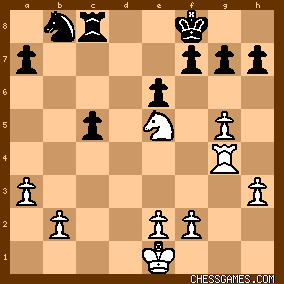
click for larger viewMaterial is even, but White has an initiative and more active pieces. Although Black can defend resourcefully, <17…Ne4> and <17…Ba8> probably present defensive options that are easier for Black to uncover. <26.Rh4> is probably the most difficult move against which to defend, eg <26…f6 27.gxf6 gxf6 28.Nd3>: 
click for larger viewWhite’s pieces are in front of its pawns probing the Black pawn formations, while Black’s pieces are behind its pawns trying to cover all weak points. Black may succeed, but it would be a taxing effort with very little counter play to which he could look forward. If, for example <28…c4 29.Nf4 e5 30. Nh5 Kf7 31. Ng3> and the Knight prances around loosening White’s position in conjunction with the rook, and soon the White king. The Black Knight that retreated to b1 is still there and the c-pawn will soon be lost. |
|
| Oct-07-10 | | visayanbraindoctor: PART 9
GAME MOVE 18:
<18. Bb4> ( 0.79)
Polgar: <”"The endgame had looked pretty equal to me, but suddenly I started to experience some problems," Kramnik admitted.”> Pein: <”Preventing c5, or so it seems. It was at this point I realised belatedly that the rook on g1 was coming out via g3 after bishops are exchanged which means the white king is also very well placed.”> GAME MOVE 18:
<18…c5> ( 0.94)
<Engine preferences>: <18...Nfd5> and by transposition <18. Rfe8> ( 0.79). Illescas-Cordoba: <”Three dubious move in a row and black is already in trouble. This pawn sacrifice could work but calculation is needed and Kramnik seemed simply unable to sit and work hard. [Of course not 18.. Nfd5?! 19.Ne5 when white would be better; The modest 18...Rfe8 19. Ne5 Bg2 20. Be7 Re7 21. Rg2 c5 22.dc5 Rc5 23. Rc5 bc5 24.Rg3 led to a very pleasant endgame for white but again black should not loose.]”> Pein: <”This does not work out. Karpov frowned. One possible line was 18...Rfe8 19.Bxe7 Rxe7 20.Ne5 Bxg2 21.Rxg2 c5 22.dxc5 Rxc5 23.Rxc5 bxc5 24.Rg3 .”> Rogers: <[?!] ”Kramnik rejected 18...Rfe8 because of 19.Bxe7 Rxe7 20.Ne5 Bxg2 21.Rxg2 "when I am slightly worse but without counterplay and I will have to suffer for the rest of the game."Anand agreed - "After 21.Rxg2 I can try to put my knight on c6 when I can press without risk."”> Note: In three separate evaluations of 22 ply complete, lasting for a total of over 16 hours, the engine preferred <18…Ref8> and its transpositional partner <18…Nfd5> ahead of <18…c5> on each occasion. After <18…Rfe8 19.Bxe7 Rxe7 20.Ne5 Bxg2 21.Rxg2>, the engine analysis indicates <20…c5> works as after <21. dxc5 Rxc5 22. Rxc5 bxc5 23. Bxb7 Rxb7>: 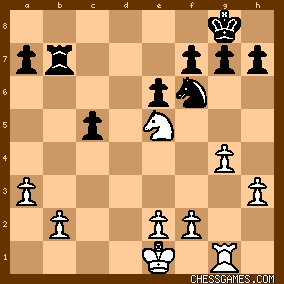
click for larger viewthe endgame is nearly equal.
If <21. g5> instead of <21. dxc5>, then <21…Nd5 22. dxc5 Rec7>: 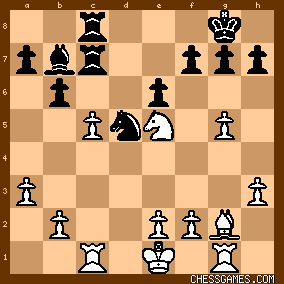
click for larger viewPerhaps this indicates that a move with a lower engine evaluation (assuming of course the engine evaluation is accurate) may on occasion be preferred to the engine’s first choice because of the counter play – real or imagined - that may be perceived as intrinsic to the lesser options. Having said this, the position in the FENs above look solid for Black, and c6 does not look especially weak. GAME MOVE 19:
<19. dxc5> ( 0.94)
Polgar: <”I think the strongest move to give Black a chance to equalize is 19...Rfd8. All other options would allow White to maintain an edge. The time is now about equal for both players at around 59-60 minutes. Kramnik has to be very careful. There is little chance that he can win this game but he must be very careful not to lose and basically put this match out of reach.”> |
|
| Oct-07-10 | | visayanbraindoctor: PART 10
GAME MOVE 19:
<19…Rfd8> ( 1.06)
Polgar: <”Kramnik found the strongest reply. A logical continuation for White is 20.Ne5 Bxg2 21.Rxg2 Nc6 22.Nxc6 Rxc6 ”> Illescas-Cordoba: <”After thinking for ten minutes on the pawn sacrifice Kramnik spent now more than twenty minutes! A clear sign that things were going wrong fro Vladimir. [It seems to me that 19...bc5! was better. Probably white should not insist in keeping the pawn and be happy to be slightly better with 20. Bc3!? (If 20. Rc5 Ne4! 21.Rc8 Rc8 black gets very good compensation.; And in case of 20.Bc5 Ne4 21.b4 Nc5 22.bc5 Bf3 23.Bf3 Rc7 24. Kd2 Rfc8 25.Rc4 Rc5 26.Rc5 Rc5 27.Rb1 g5 28.Rb7 Nc8 black may hold the endgame )] Now it comes a long sequence of moves after which Anand will consolidate his material advantage.”> <Engine preference>: <19...Nfd5> ( 0.94) <20.Nd4 Rfd8 21.Nb5 Ba6> and now either: a. <22.Nc3 Nxb4 23. axb4 Bc4 24. Ra1 Rc7 25. cxb6 axb6 26. Rd1 Rcd7 27. Rxd7 Rxd7>: 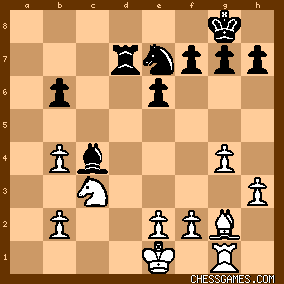
click for larger viewAnd Black should be able to defend the endgame; or.
b. <22. Nxa7 Rc7 23. Rd1 (the Knight has no retreat) 23…Rxa7 24. e4 Rc8 25. exd5 bxc5 26. Bc3 exd5 (or Nxd5) 27. Bxd5 Nxd5 (or exd5) 28. Rxd5 Re7+ 29. Kd1 Bc4 30. Re5>: 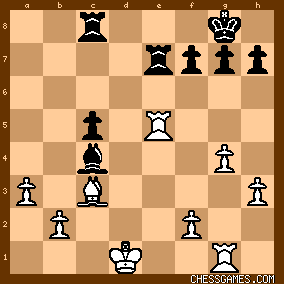
click for larger viewBlack should hold the ending, especially as any exchange of rooks will work in favor of the defending side having an opposite colored bishop. |
|
| Oct-07-10 | | visayanbraindoctor: PART 11
GAME MOVE 20:
<20. Ne5> ( 1.06) <20…Bxg2> ( 1.10) Had he played <20…Nfd5> (which is the engine’s preferred move ( 1.06), Black could have either held onto the pawn or relinquished it in circumstances more advantageous than in the game. The LSB’s diagonal is blocked by the Knight and White’s c-pawn remains pinned, ready to be recaptured at the right moment. Black does remain on the defensive against Blacks two bishops and more active pieces but should be able to hold. For example: <21.g5 Nc6 22.Nxc6 Rxc6>: 
click for larger viewWhite could bring his King rook into play via the third rank with <23. Bh1>. The main advantage of this is that any attempt by Black to use …a4 to biff the DSB off b4 produces weaknesses the rook can exploit. However, after <23…Rdc8 24. Rg3 bxc5 25. Bc3> Black can with careful play hold on with <25...Kf8>, eg: <26.Be5 f6 27.Rb3 Ba6 28.e4 fxe5 29.exd5 exd5 30.Bxd5 Rb6 31.Rf3+ Ke8 32.b3 Bb7 33.Bxb7 Rxb7 34.Ke2 Rd7 35.Re3 Rd5 36.Rd3 Rd4>. If after <21.g5 Nc6 22.Nxc6 Rxc6> (the position after the previous FEN), White tries something like <23.h4>, then after <23…Rdc8> and White has some pressure but material is even, and Black has excellent rooks; eg: <24.h5 (or <24. Bd2 Rxc5 25. Rxc5 Rxc5 26. Be4 Bc6 or 26…g6 or 26…Ba6> all hold the fort) 24…a5 25.Bd2 (<25. Bxd5 exd5 26. Bc3 Rxc5> is OK for Black) 25…Rxc5 26.Rxc5 (<26. Kd1 Rxc1+ 27. Bxc1 Bc6! => equalizes) Rxc5>: 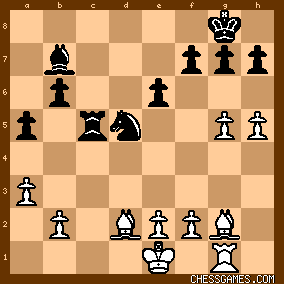
click for larger viewBlack has recovered his pawn with his position intact. White has the two bishops and some initiative, but this is much more defensible than the line actually played. GAME MOVE 21:
<21. Rxg2> ( 1.10)
Polgar: <”Now Kramnik faces a few choices: 21...a5, 21...Nc6, 21...bxc5, 21...Nfd5. Which one will give Black the best path to equalize? 21... a5 22. Bd2 Rd5 23. Nd3 bxc5 24. Rc4 . I briefly looked at all lines and White maintains an advantage in all of them.”> GAME MOVE 21:
<21…bxc5> ( 1.10)
Rogers: <”An admission of failure; now White will be a pawn ahead for negligible compensation. On 21...Nc6 White has no need to enter complications with 22.cxb6!? but can keep it simple with 22.Nd3!.”> Pein: <”Staying a pawn down. Kramnik said he thought the ending was equal at first but then realised he had some problems. However the cure is worse than the disease as he never recovers the pawn, he must have missed a tactical point 21...Nc6 22.Nd3! and White must avoid 22...Nd4 23.cxb6?? Rxc1+ 24.Nxc1 Nc2+ 25.Kf1 Rd1+; but 21...Nc6 22.Nd3! Nd4 23.e3! Nb3 24.Rc3 ; 21...a5 22.Bd2 Ne4 23.cxb6 Rxd2 24.Rxc8+ Nxc8 25.b7 Rc2! 26.Kd1! wins.”> Polgar: <”Let's examine one possibility 22.Bxc5 Ne4 23.b4 Ng6 24.Nd3 White is basically playing for 2 results. With Black's best play, he can only hope for a draw.”> |
|
| Oct-07-10 | | visayanbraindoctor: PART 12
GAME MOVE 22:
<22. Rxc5> ( 1.10) <22…Ne4> ( 1.10) Pein: <”It's just a solid pawn up for White”> GAME MOVE 23:
<23. Rxc8> ( 1.10) <23…Rxc8> ( 1.10) Polgar: <”Black is down a pawn but his White's Rook is temporarily out of play. White is still better.”> GAME MOVE 24:
<24. Nd3> ( 1.10) <24…Nd5> ( 1.10) Polgar: <”Black will have his work cut out to draw this game. Either 25.Bd2 or 25.g5 is good.”> GAME MOVE 25:
<25. Bd2> ( 1.10)
Polgar: <”Black has a couple interesting moves here. One is 25...Rc2 26.Bc1 f5 and the other is 25...Nb6 with the idea of going to c4.”> GAME MOVE 25:
<25…Rc2> ( 1.26)
The <main engine preference> is the slightly more passive <25…Nb6> ( 1.10): <26.Bf4 (or <26. Be3>) 26…Nd5 27. Bc1 f5 (intending <28…Kf7>) 28. gxf4 exf4 (<29. Bh6 g6 30. f3 Nc5> and the exchange of Knights eases Black’s game somewhat) 29. f3 Nc5 and again the exchange of Knights helps Black.> GAME MOVE 26:
<26. Bc1> ( 1.26)
Rogers: <”"Black is very close to having compensation," Anand confessed, "but I think I controlled [the game] very well."”> This underscores the difficulty of this game. Black has close to a losing game, and in fact does so after the next move, but this is not evident from the comments of the masters watching, or even the participants. Sometimes a blunder can be a very subtle move indeed. |
|
| Oct-07-10 | | visayanbraindoctor: PART 13
GAME MOVE 26:
<26…f5> ( 1.50)

click for larger viewRogers: <”A second bid for counterplay. 26...Nc5 27.Kd1 Nxd3 28.exd3! (Not 28.Kxc2?? Ne1+) 28...Rc8 gives Black a great knight on d5 but after 29.f3! and 30.Rc2, the position must be a slow but sure win for White.”> Polgar: <”White has a few reasonable responses. 26.Kd1, 26.gxf5 or 26.Rg1. White is better in all three lines.”> Illescas-Cordoba: <”Kramnik finds the most stubborn defence. White has problems to get his rook into play.”> Black’s move 26 is a blunder as it produces a lost position (evaluation >1.40). Because none of the analysts, three of whom are GMs, spotted this as an error, let alone as a losing move (one even gave it an !), this analyst spent considerable amount of time investigating the length and depth of many variations that spring from this move, to reassure himself that the evaluation validly expressed a lost game for Black. Some of the analysis is in later posts in this series, but it is a deeply complex and subtle endgame, requiring enormous patience to prosecute; and the analysis is by no means complete. There are numerous subvariations where the slightest mistake can cancel the winning advantage, and moreover with branching subvariations at many, sometimes successive, moves of almost equal value. There are quite a few variations with moves that can only be described as machine moves, that humans probably wouldn’t think of playing, eg: setting up the capture of a central pawn in the endgame, and having achieved that capacity then resists capturing to support other advances on the board. The analysis has been saved and is accessible to the curious and/or the masochistic. It’s worth noting that the >1.40 evaluation for this move did not emerge until after considerable engine time and frequently goosed analysis; it was necessitated by the need to spend additional time ironing out inconsistencies in the engine’s evaluations of the moves in this part of the game. <Main engine preference>: <26...Nc5> (±1.26): <27.Kd1 Nxd3 28. exd3>: 
click for larger viewOnce the rook retreats, Black’s position is very difficult and maybe even indefensible, as Rogers pointed out. White’s rook swings over to c2 and Black has to concede the c-file or face a lost B vs N ending. The penetration of the rook combined with the King and Bishop to shepherd the queen side pawn majority will make Black’s life miserable. After extensive testing of many variations, there appears to be no forced win. Most variations do in fact end in a win for White, indicating that in practical play White would usually win, as Black has to be excruciatingly accurate to survive this sort of ending. On careful examination of the critical moves, this analyst has always found a saving resource for Black, and comes to the conclusion on the balance of probabilities that there is no forced win for White in the position starting from <26…Nc5>. It is understandable that Kramnik avoided this variation for a wilder bid for freedom (26…f5), and in its own way the latter move pays off as Anand lets him off the hook in subsequent play. Accordingly, the exclamation mark awarded by GM Illescas for Black’s 26th move is deserved as it describes Black’s best practical bid for freedom, but under the cold hard pitiless and <unhuman> scrutiny of the machine, it constitutes a blunder as it must lose if White conducts the response perfectly. <The blunder <<26…f5>> adds <<2.0>> to the game’s error weighting.> |
|
| Oct-07-10 | | visayanbraindoctor: PART 14
GAME MOVES 27-28:
<27. Kd1> ( 1.50) <27…Rc8> ( 1.52) <28. f3> ( 1.52) <28…Nd6> ( 1.52) Polgar: <”White is still working on getting his Rook active. If he is able to do that, he will have good chances to score a full point. It is obviously not a simple task.”> GAME MOVE 29:
<29. Ke1> ( 1.09)
Polgar: <”An unusual move in this position but it does not do any harm to his position. 29.Rg1 is more logical to me.”> Pein: <”Karpov advocated Rg1 as a better way to avoid any knight forks but this is also good. Vishy takes it nice and slowly.”> Rogers: <”?!”>
<29. Rg1> is indeed a better choice ( 1.29), however only <29. e3> opening the second rank to the rook to enable access to the c-file actually maintains the win. As foreshadowed after Black’s blunder with <26…f5>, the endgame is obscure and difficult, and took extensive verification of numerous variations to confirm that the engine’s assessment of the position since Black’s 26th move is indeed correct, and not a machine aberration or symptomatic of endgame ineptness by the engine. The <main variation> proceeds as follows: MAIN VARIATION MOVE 29:
<29. e3>:

click for larger viewClearing the second rank, ready to oppose and exchange rooks on the c-file. MAIN VARIATION MOVE 29:
<29…fxg4>
Black could also try <29…Nc4>, but to little avail, eg: <30. Re2 (…31. e4 with greater effect than in the main variation because of the presence of Black’s f-pawn) 30…Rd8 31. Kc2 Rc8 32. Kb3 Na5+ 33. Ka2> and now if: (a) <33…Nc6 34. e4 Nd4 35. Rf2 Nb6 36. Be3 Nc2 37. Bxb6 axb6 38. Ne5 threatening 39. Rd2> wins (b) <33…Rc3 34. Rd2> and after the Black rook moves, White will exchange pawns on f5 and follow with e4 and/or Ne5 with a winning bind. (c) <33…fxg4 34. hxg4> threatening e4 and f4 wins, eg: <34…Nc6 35. e4 Nde7 36. Rc2> with a routine win. MAIN VARIATION MOVE 30:
<30. fxg4>:

click for larger viewIf <29. hxg4>, then <29…Nc4 30. Re2 Rf8 31. f4 (31. Ne1 is passive) 31…Rd8 32. Kc2 Rc8 33. Kb3> is similar to the main variation being developed here, but after <33…Nf6>, the unprotected g-pawn needs to be protected with the rook, diverting it from its mission on the c-file, or the pawn has to advance to <34. g5> after which Black has <34…Ne4>: 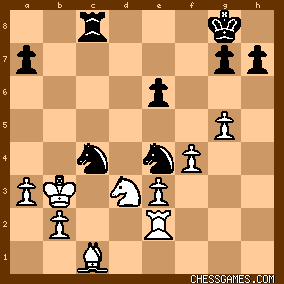
click for larger viewthreatening <35…h6> with sufficient counter play in light of White’s passive bishop and underused rook, and his own active pieces and solid defensive formation to be hopeful of securing a draw and neutralizing the queen side pawn majority, eg: if <35. Rg2 g6 36. Ka2 Na5> holds the line. |
|
| Oct-07-10 | | visayanbraindoctor: PART 15
MAIN VARIATION MOVES 30-31:
<30…Nc4 31. Re2>:
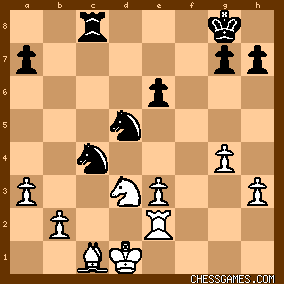
click for larger view<31. Ke2> blocks the rook, and <31. Rg3> consigns the rook to passive guard duty. The text threatens <32. e4> followed by <32. Rc2> to great effect. MAIN VARIATION MOVES 31-34:
<31…Rd8> (threatening <31…Ndxe3+ and 31. Ne5>) <32. Kc2> (still threatening <33. e4> and also <33. b4>) <32…Rc8 33. Kb3> (again threatening <34. e4>) <33…Na5+ 34. Ka2> (threatens both <35. e4> and <35. Bd2>) <34…Rc3>:
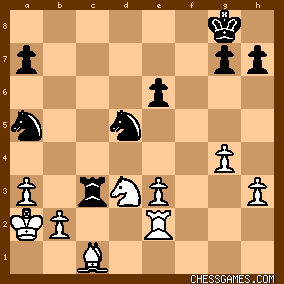
click for larger viewThis spectacular move temporarily meets both threats as <35. e4> would dissipate White’s win after the exchanges: <35…Rxd3 36. exd5 exd5>. More important than the temporary concession of a pawn, this exchange would allow Black’s rook to be active behind White’s lines. MAIN VARIATION MOVE 35:
<35. Re2>
The only move, but sufficient to maintain winning momentum. Black can only buy time, not salvation. MAIN VARIATION MOVE 35:
<35…Rc8 36. Rh2 (threatening 37. e4) and White has a smorgasbord of choices from each of Black’s most viable replies, including <36…Nb6>, <36…Nf6>, <36…a6>, <36…Rc7>, <36…Nb7> and <36…Rc4>. White’s basic strategy will be to use his pieces to maximize his extra pawn and to shepherd his queen side majority forward, gradually tying down Black’s defenses, and forcing the extra pawn through with decisive effect. The shortcoming of <26…f5> to the alternative defence <26…Nc5> that was discussed previously is that with <26…Nc5>, Black can set up a defensive formation on the King side, typically consisting of pawns on g5, f6 and e6, and possibly also h6 depending upon whether h-pawns have been exchanged, with a Night on d5 and the rook on the second rank, whereas those defensive (and extremely tedious and difficult) possibilities are not available in this variation. Some of the subvariations that emanate from Black’s 36th move have been explored, but have not been included here for space considerations. Anyone interested is invited to explore those subvariations themselves and compare notes with my own findings. CONCLUSION: <As <<29. Ke1>> brings the evaluation well below 1.41 , it constitutes a blunder and adds a further <<2.0>> to the games error weighting.> |
|
| Oct-07-10 | | visayanbraindoctor: PART 16
GAME MOVE 29:
<29…a5> ( 1.09)
Illescas-Cordoba: <”Maybe it was better to insist on 29...Rc2!? Here is a sample line: 30.Rf2 Ne4!? 31.fe4 fe4 32.Bg5! ( 32.e3?! Rc8 ) 32...h6! 33.Bh4 ed3 34.ed3 Rc1 35.Kd2 Rh1 and white is better but black gets some counterplay.”> NOTE: <29…Rc2> would lose to <30. Kd1> chasing the rook away as after <31. e3> it would transpose to the main variation discussed previously. <29…a5> seems to be Black’s best move. GAME MOVE 30:
<30. e3> ( 1.14)
Not as useful now as the rook cannot contest the c-file, and the King is offside…it should be at a2 or a4 supporting the advance of its quite side pawn majority. <Engine preferences>: 1. <30.Rg1> ( 1.09): <30…a4 31.Kf2 Nc4 32.gxf5 exf5 33. e4 fxe4 34. fxe4 Nf6 35. Kf3 Nd7> is solidly defensive, eg: <36. Bf4 Nc5> or <36. Rg5 Rf8+>. 2. < 30.gxf5> ( 1.07) <30…exf5 31.Bh6 g6 32.Kf2 a4 33.Rg1 Nc4> and having stymied White’s queen side majority, Black has active pieces and enough counter play to survive. If now <34. Rc1> then <34…Ndb6> holds, GAME MOVE 30:
<30…e5> ( 1.26)
Threatening 31…e4.
Polgar: <”This is dangerous as Black is about to sacrifice another pawn. 30...a5 is safer for Black.”> Illescas-Cordoba: <”!? Again black finds the way to complicate the game but Vishy kept cool.”> Pein: <”With Kd1 and Rc2 coming Kramnik seeks activity but with less time on the clock to calculate this also backfires.”> Rogers: <”!?”>
<Main engine preference>: <30…a4> ( 1.08), eg: if <31. Re2 (threatening 31. gxf5 followed by 32. e4) 31…Nc4 32. e4 fxe4 33. Rxe4 e5 34. Bg5 Ndb6 35. Be7 Nd5 36. Nxe5 Nxb2 37. Bd6 Rd8 Re2 Nd1>: 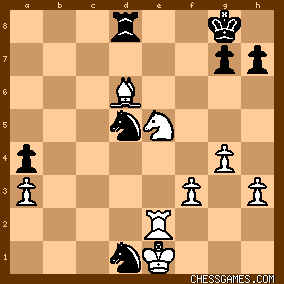
click for larger viewWhite has the pawn, but Black has it corralled and has plenty of piece activity; with careful footwork, he should be able to secure a draw. GAME MOVE 31:
<31. gxf5> ( 1.26) <31…e4>( 1.26) Rogers: <”!”>
The logical follow up to the previous move. If <31…Nxf5 32. e4 Nh4 33. Rg3 Nb6 (intending 34…a4) 34. Bg5 Ng6 35. h4 Nd7 (protecting e5) 36. h5 Nh8 (36…Ngf8 37. Bh6> wins a pawn and wins by force)>: 
click for larger viewAnd Black is getting pushed off the board, eg: <37.Bh6 g6 38.Bd2 a4 39.Bc3 Re8 40.Rg1> and Black will be cracked like a walnut as he is virtually in zugzwang. |
|
| Oct-07-10 | | visayanbraindoctor: PART 17
GAME MOVES 32-33:
<32. fxe4> ( 1.26) <32…Nxe4> ( 1.26) <33. Bd2> ( 1.26)
GAME MOVE 33:
<33…a4> ( 1.90)
Polgar: <” White can slowly unlock his position and capitalize on the material advantage with 34.Nf2 Nd6 35.Ke2 . Even though it is not an easy task, White has chances to win this endgame.”> Rogers: <” Kramnik targeted this move as his decisive error, "although of course the position is not pleasant."This is something of an understatement - perhaps only 33...Re8 sets up some tricks, hoping for 34.Bxa5? Nxe3! when Black is back in the game.”> Pein: <”33...Rc2 34.Kd1?? Nxe3+; but 33...Rc2 34.Re2 Nxd2 35.Kd1 Nxe3+ 36.Rxe3 Nc4 37.Kxc2 Nxe3+ 38.Kb3 Nxf5 39.Ka4 is easy; 33...Re8 was better.”> Illescas-Cordoba: <” Kramnik pointed this move as the final mistake at the press conference. Probably he was right. [ Black could get more drawing chances with 33...Rc2!? ; or 33...Re8!? while admitting white is still clearly better.]”> The losing move…Black’s game is lost after this and remains that way. <33…Re8> ( 1.26) was necessary: If <33...Re8>, the engine recommends <34.Nf4 Nxf4 35.exf4>: 
click for larger viewThe discovered check isn’t dangerous. White threatens <36. Bxa5 and 36. Re2>. <35…Nxd2+ 36.Kxd2>:

click for larger viewDespite the two extra pawns, White does not have a win, eg: <35…Kf7 37. Re2 (37. Kd3 is an alternative, but not 37. Kc3? Re3+) Rb8 38. Kc3 Kf6 39. Re6+ (White has to give up the f-pawns so he can capture the a-pawn, because if Black can slip the a4 move in, he has a draw – an alternative is 39. Re4 preventing 39…a4, but this is also defensible for Black) 37…Kxf5 38. Re5+ Kxf4 39. Rxa5>: 
click for larger viewWith a likely draw.
Another alternative to <39. Re5+> is <39. b4>: 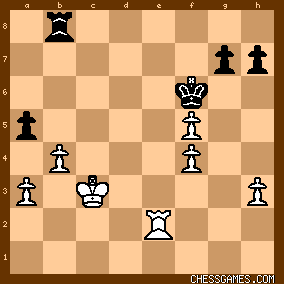
click for larger viewIf <39…axb5>, then <40. axb5 Kxf5> with a likely draw. <Black’s <<33…a4>> is a blunder for the purposes of this project as it crosses the 1.40 boundary to 1.90 to a lost game. This therefore adds 2.0 to the game’s error weighting.> |
|
| Oct-07-10 | | visayanbraindoctor: PART 18
GAME MOVE 34:
<34. Nf2> ( 1.90)
Illescas-Cordoba: <”! After this move white gets the coordination he was lacking.” Pein: <” ! The computer assessment jumped as Anand stays two pawns up.”> Rogers: <”!”
GAME MOVE 34:
<34…Nd6> ( 2.03)
Polgar: <” Kramnik and his team must be scratching their heads. He is being outplayed in complicated positions which typically favor Anand and he is also being outplayed by Anand in a dull and quiet position which supposed to favor Kramnik. They have to figure things out quickly as we are at the half way point of this very short match.”> The <engine preference> is <34...Nxf2>, but only by a small margin. Black is lost GAME MOVE 35:
<35. Rg4> ( 1.65)
<Engine preference> is <35.Ke2>, but this makes no difference as again the margin of differences is small. The move played by White clearly wins. GAME MOVE 35:
<35…Nc4> ( 2.32)
Polgar: <” Kramnik chose not to win back one pawn with Nxf5. He instead chose to go after the b2 pawn. 36.Nd1 would give White a serious advantage.”> Illescas-Cordoba: <” [ After 35...Nf5 36.Ra4 Nde3 37.Be3 Ne3 it would be a matter of technique ]> The <engine preference> follows GM Illescas-Coredoba: <35...Nxf5 36.Rxa4 Ndxe3 37.Bxe3 Nxe3>. However, as he points out it is a matter of technique. GAME MOVE 36:
<36. e4> ( 1.90)
Illescas-Cordoba: <”[ Why not a simple retreat? After 36.Nd1! Anand told me that he was worried with the blockade of the black knights but to my view after Kf7 37.Rd4 Ndb6 38.Bc3 white is simply two pawns up. ]”> <Engine preference> is also <36.Nd1> (2.32 ) GAME MOVE 36-37:
<36…Nf6> ( 2.20)
<37. Rg3> ( 1.90)
<Main engine preference> is <37. Rg5> ( 2.20). |
|
| Oct-07-10 | | visayanbraindoctor: PART 19
GAME MOVE 37:
<37…Nxb2> ( 2.63)
Illescas-Cordoba: <” Takes one pawn back but the position is still lost. [After 37...Ne4 there is a forced variation: 38.Ne4 Re8 39.Bc3 Re4 40.Kf2! Ne5 41.Re3! Re3 42.Ke3 and white is easily winning here ]”> Polgar: <” I think a better move is 37..Nxe4 38.Nxe4 Re8”> <Main engine preference>: < 1.90: 37...Nxe4 38.Nxe4 > GAME MOVE 38:
<38. e5> ( 2.63). Crushing. Rogers: <” 38.Bc3 Nh5 is not so clear.”> Illescas-Cordoba: <” A precise move which is a giant step to the victory. [ weaker would be 38.Bc3? Nh5! ]”> Pein: <” ! [38.Bc3 Nh5]”> Note: <38. Bc3> is a blunder as it concedes a winning position. <38. Bh6> also wins (if 38…Ne6 39. f6 and if 38…Rc7 39. e5). GAME MOVE 38:
<38…Nd5> ( 4.59)
Illescas-Cordoba: <” [ Anand was worried with 38...Re8 39.Bc3 Nc4 40.e6 Nd6! but then he saw 41.Ng4! (instead of 41.Bf6? Nf5! ) 41...Nfe4 42.Nh6! and white is winning ]”> Polgar: <” And now 39.f6 is coming. Kramnik is in serious trouble. 38...Re8 offers more resistance but it is still extremely very difficult to hold.”> <Engine also prefers <38...Re8> (2.63 ) 39.e6 Nc4 40.Bc3 Nd6 41.Ng4>. GM Illescas’ continuation wins as does <41…Nxg4 42.hxg4> GAME MOVE 39:
<39. f6> ( 4.60)
Polgar: <” It looks like the score may be 4.5-1.5 after this game. The connected passed pawns are just too much for Black to handle. This is why I think Kramnik should have played 35...Nxf5.” GAME MOVE 39:
<39…Kf7> ( 5.39)
Illescas-Cordoba: <” The game is over [ 39...g6 was also loosing after for example 40.Ne4 ]”> Rogers: <”Desperation. "I saw 39...g6 40.Ne4! when it's time to resign," said Anand, his tactical point being 40...Re8 41.f7+!.”> GAME MOVE 40:
<40. Ne4 ( 5.39) <40…Nc4> ( 6.66) Polgar: <” Next will be 41.Rxg7+ and the game is about over 41...Ke6 42. Ng5+ Kxe5 43. f7 Rf8 44. Nxh7 “> GAME MOVE 41:
<41. fxg7> ( 3.71)
Polgar: <” Not as decisive as 41.Rxg7+ but still winning. Rg8 42. Nd6+ Nxd6 43. exd6 Ke6 44. Bh6 Kxd6 45. Rf3 “> Rogers: <” "Probably 41.Rxg7+ wins easily as well, but I couldn't be bothered working it out," Anand confessed, "since I saw that what I played was winning."”> Illescas-Cordoba: <” [It was faster 41.Rg7! Ke6 42.f7 ]”> Pein: <” An echo of game 3 where Anand also missed a quicker win. 41.Rxg7+ Ke6 42.Ng5+ Kxe5 43.f7 Nxd2 44.Rg8 .”> <Main engine preference>: ( (6.66): <41.Rxg7+ Ke6 42.f7 Nxd2 43.Kxd2 Rf8 44.Ng5+ Ke7 45.Rxh7 Nb6 46.Kc3 Nd5+ 47.Kc4 Ne3+ 48.Kb5 Nc2 49.Kxa4 Nd4 50.Rh6 Ra8+ 51.Kb4 Rb8+ 52.Kc4 Nf5 53.Re6+> |
|
| Oct-07-10 | | visayanbraindoctor: PART 20
GAME MOVE 41:
<41…Kg8> ( 5.60)
Illescas-Cordoba: <” [After 41...Rg8 white may win with 42.Nd6 Nd6 43.ed6 Ke6 44.Bh6 Kd6 45.Rf3 Ne7 46.Rf8 where black king cannot avoid the defeat, i.e.: Kd5 47.Kd2 Kc4 48.Ke3 Kb3 49.Kd4 Ka3 50.Kc5 Kb3 51.Kd6 ]”> Polgar: <” Now Anand can close it out with 42.Rd3. All other lines will just prolong things.”> <Engine preference> (3.71): <41...Rg8 42.Nd6+ Nxd6 43.exd6 Ke6 44.Bh6 Kxd6 45.Rf3> GAME MOVE 42:
<42. Rd3> ( 5.60)
Illescas-Cordoba: <” The last precise move Anand had to find. This wins by force. [ His original idea was 42.Nf6? Nf6 43.ef6 but then he saw that after Re8! 44.Kd1 Rd8! 45.Kc2 Rd2 46.Kc3 Rf2 47.Kc4 Rf6 48.Kb5 Rf4 black could get this rook endgame which he thought should be winning but was not sure. In fact it may be a draw, i.e.: 49.Rg4 Rf3 50.Ka4 Rh3 51.Kb4 h5 52.Rg1 Rh4 53.Kb5 Rg4 ]> Pein: <” There was a diabolical line: 42.Nf6+ Nxf6 43.exf6 Re8+ 44.Kd1 Rd8 45.Kc1 Nxd2 46.f7+ Kxf7 47.g8Q+ Rxg8 48.Rxg8 Nb3+! Spotted by David Norwood.”> Note: The engine confirms that the line Anand avoided is indeed a draw. GAME MOVE 42:
<42…Ndb6> ( 5.92)
Polgar: <” White has 43.e6 Kxg7 44.Rg3+ Kf8 45.Bb4+ and mate coming soon.”> Illescas-Cordoba: <” The only square to prevent white's rook entering on the seventh rank.”> GAME MOVE 43:
<43. Bh6 ( 4.34)
Illescas-Cordoba: <” [It was nicer 43.e6 Kg7 44.Rg3 Kf8 45.Bb4 Ke8 46.Rg8# ]”> GAME MOVE 43-44:
<43…Nxe5> ( 4.34)
<44. Nf6+> ( 4.34) <44…Kf7> ( 4.34) Polgar: <” White can play 45.Rc3 and Black will lose more material to the threat of g8(Q)”> GAME MOVE 45:
<45. Rc3> ( 4.34)
Pein: <”A crowd pleaser.”> GAME MOVE 45:
<45…Rxc3> ( 6.84)
Illescas-Cordoba: <” [ Of course 45...Nbc4 46.g8Q Rg8 47.Ng8 Kg8 48.Bf4 is hopeless for black ]”> GAME MOVES 46-47:
<46. g8=Q+ ( 7.95) <46…Kxf6> ( 7.95) <47. Bg7+> ( 7.95) Black resigned Final position:

click for larger view<CONCLUSION>
<Using method A, the game is weighted at <<6>>, representing <<2 blunders>> by Kramnik and <<1 blunder>> by Anand.Using method B, the game is weighted at <<6.5>> representing <<2 blunders>> and <<1 dubious move>> by Kramnik and <<1 blunder>> by Anand. Kramnik's <<blunders>> were <<26...f5>> and <<33...a4>> and his <dubious move> was <9...b6>. Anand's <<blunder>> was <<29. Ke1>>.> |
|
| Oct-07-10 | | visayanbraindoctor: Again this is the analysis of User: Bridgeburner This superb and thorough analysis clearly shows the subtleties of a complicated and difficult endgame. The fact that both Anand and Kramnik went through it with a minimal number of mistakes illustrates chess at the highest human levels. |
|
Dec-22-10
 | | Phony Benoni: Not much to add to 48 pages of kibitzing on what seemed total domination by Anand. Before I go plowing through that mess, does anybody have an idea what the pun relates to? |
|
| Dec-22-10 | | thathwamasi: <Phony Benoni> This was a pun submitted by myself through the pun submission page. After Anand won two games with black, his win with white seemed minor and harmless...infact resulting in greater good...and hence I called it "white lies" - Thanks |
|
Dec-22-10
 | | Phony Benoni: <thathwamasi> Thanks. |
|
Dec-22-10
 | | Check It Out: This is an amazing game, and that analysis by <bridgeburner> is amazing as well. It seems to me that the chess between Anand and Kramnik was a level above that of Anand and Topalov, though that is just a gut-level feeling. |
|
| Dec-22-10 | | talisman: great game of the day...thanks for the analysis. |
|
| Dec-22-10 | | kevin86: A great game! It's nice to see another queen around the house. |
|
| Dec-22-10 | | WhiteRook48: Bg7+ nice regaining tactic |
|
| Mar-11-11 | | pablo333: I have sifted through forty-eight pages of Kibitz text in search of an answer; but to no avail. Therefore: can anyone explain the reasoning behind 6... Qf5? Surely the whole point of black recapturing the pawn with his Queen on move five is to obtain a lead in development - secured by his b4 Bishop's pin of the c3 Knight. Having gotten the superior development he was aiming for, what then prompted Kramnik to abandon his strategy by wasting a valuable tempo (moving his Queen a second time in the opening)? |
|
| Mar-11-11 | | picard: pablo i think he was simply hoping for 7. Qxf5 exf5 Sure, it doubles up pawns but gives black control of e4. Later black might fianchetto his bishop, with the goal of putting either it or the knight onto e4. |
|
 |
 |
|
< Earlier Kibitzing · PAGE 48 OF 49 ·
Later Kibitzing> |
|
|
|





